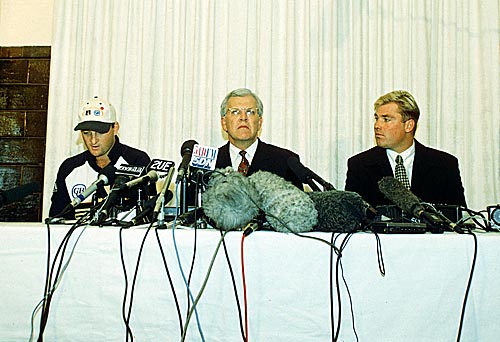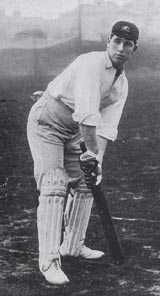Inside Story: Unlocking Australian Cricket's Archives
By Gideon Haigh and David Frith (News Custom Publishing)
A$69

Secrets in Cricket Australia's headquarters have been trying to escape for more than a century. Historically, pleas for the nitty gritty on scandals have been denied more than legspinners' love affairs and board members have been as accountable as great uncles with Alzheimer's. For 68 years the body was known as the Australian Board of Control for International Cricket and the craving for absolute power remained despite subsequent name changes.
So it was surprising and intriguing when the board commissioned a "warts and all" history, giving Gideon Haigh and David Frith, the writers and historians, a dustpan and brush to gain archive access. Wowed by the collection of documents and meeting minutes, the authors confirmed cover-ups and an attitude of evasiveness and secrecy. Siding with the players, whether they were right or wrong, becomes easier with each chapter and it is hard to feel sympathy for the stuffy and superior administrators.
The Mark Waugh-Shane Warne bookie scandal of the 1990s is a classic example of the board's inaction and the bungling of the issue is looked at in depth. Waugh and Warne were fined in 1995 for giving information to a bookmaker known only as "John" and the punishment was hidden from the public for four years. However, it was not only the public who were disappointed at the poor handling of the affair.
While the original minutes recorded the matter being dealt with in "a manner considered appropriate", some members had already left the meeting - one was on a plane to the West Indies - and Graham Halbish, the chief executive, and Alan Crompton, the chairman, rushed through the facts about the players' dealings with "John", while the remaining attendees were packing up. Catching planes on time was more important than dealing with an incident that showed Australia could not afford to point self-righteous fingers at the subcontinent.
"We got pizzled," the future chairman Bob Merriman said. "Absolutely pizzled. I don't know what the vote was, because there was nobody there." Denis Rogers, soon to be the chairman, said he was "scared" and wished he'd said more. The board member Damien Mullins said it was "poor and unsatisfactory" and admitted the directors were rightly criticised when the episode was exposed. While the coverage of the bookmaker dealings and global match-fixing atmosphere is excellent, the "naïve and stupid" fallout is covered in less than a page, which is minor given how exhaustive the book is otherwise.

|

Naive and stupid: Mark Waugh, Malcolm Speed and Shane Warne after the bookie affair was exposed in 1999
© AFP
|
|
Inside Story is a beautifully presented and invaluable resource, but those who expect the secrets to whoosh out like freed ghosts at Harry Potter's Hogwarts will be frightened by the 285,000 words. It requires committed reading to absorb the comprehensive accounts, which are usually covered in immaculate detail. Anyone who has grown lazy with modern cricket books, with their booming signposts to controversy and chapters short enough to satisfy attention deficit disorders, will squirm as much with the pages of print as with the choices of the board.
Privacy was paramount to the band of aloof officials, who sometimes spent days debating matters of serious and trivial consequence. Malcolm Speed's first meeting after becoming chief executive in 1997 contained an animated discussion over how long wives would be allowed on the Ashes tour, a topic familiar to Bradman and his team-mates, some of whom had their partners stay in France so they could be visited without contravening rules which stated partners could not stay in England.
Two chapters focus heavily on Bradman, covering his early concerns over Bodyline, how his part-time journalism was in opposition to his contract and his move into administration. Bradman's typed ratings of the team hotels on the 1948 tour - "London, Piccadilly: Bad, get another" - show how obsession sat next to invincibility.
He certainly behaved better than one of predecessors as leader. Clem Hill, who captained Australia in ten Tests, was involved in literally the bloodiest administrative pow-wow of the board's history when he fought with Peter McAllister during a 1912 selection meeting.
"Hill stood up and leaned across the table," the board secretary Syd Smith recalled. "He told McAllister that he had been looking for a 'bloody punch in the jaw all night' and that he was going to give him one. With that, he dealt him a terrific blow in the face. They came to grips, with Hill, the younger man, having the better of the struggle." Hill resigned as a selector and was also part of a rebel group known as the "Gang of Six", including Victor Trumper and Warwick Armstrong, which had its invitations for the following tour of England withdrawn over a dispute over how the manager would be paid.

|

Clem Hill's fight over selection started when he told Peter McAllister he'd been looking for a "bloody punch in the jaw all night"
© Getty Images
|
|
The treatment by another unyielding board of Sid Barnes, the wonderful batsman, was less violent but equally severe. His selection for the 1951-52 series against West Indies was rejected by the board on "grounds other than cricket ability", a regulation not used since the Gang of Six were shackled in 1912.
Barnes was also a first-class agitator who upset the board by lampooning them in his newspaper columns and home movies, and there were complaints about him taking pictures of the royal family, "abducting" Ernie Toshack to play tennis and selling luxury goods to the English on the '48 tour. There is a wonderful picture of Barnes in 1952, the summer after his selection rejection, fulfilling his 12th-man duties for New South Wales dressed as a butler at a posh picnic, adding to the administrative angst. The events surrounding the affair, which included a court case for defamation, are hilarious for the modern observer, but were sad for Barnes, whose Test career was over.
The overworked vetting pencils at Cricket Australia deserve credit for allowing the board to look so ridiculous and adhering to the "warts and all" foundation. At times in the concluding chapters the book veers towards company promotion mixed with contemporary history, but it is after all an in-house publication for a body that believes in catchphrases such as "Spirit of Cricket" and "From Backyard to Baggy Green". And fist fights and bookie revelations have been rare since the board's 2003 reincarnation as Cricket Australia.
Peter English is the Australasian editor of Cricinfo


